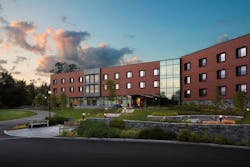Passive House Design Is Creating a Pathway to Highly Efficient Buildings
As architects and designers, we are always pushing the bounds of current innovation to build a more sustainable tomorrow. However, one of the most promising architectural solutions for combating climate change was developed decades ago.
A rising trend throughout the industry, Passive House design—a standard first pioneered by Dr. Wolfgang Feist in 1980s Germany—lays the groundwork for creating highly energy-efficient buildings through five basic principles: thermal insulation; highly efficient windows; ventilation with heat recovery; air tightness; and thermal bridge free design. Today, the concept has developed into one of the most rigorous construction standards in the world, offering a pathway to significantly cut down greenhouse gas emissions and achieve net zero, or even net positive, at a much wider scale.
Differing from other well-regarded, sustainable building approaches like LEED, Passive House is a performance-based standard that directly addresses the problem of energy use. It creates testable performance levels of a structure’s exterior walls, and therefore very quantifiable and verifiable energy levels.
Typically, when these principles are holistically applied, Passive Houses use 40 to 60% less energy than conventional buildings, leading to major cost reductions, and in some scenarios, can even cut down energy use by up to 90%. While achieving this is no easy feat, the focus throughout the planning and construction process relies heavily on creating the envelope of the building and applying superinsulation and airtight construction throughout.
[Related: Gensler Reimagines the Next Generation of Science Buildings Using Mass Timber]
Going Beyond Efficiency
Beyond its energy efficiency benefits, Passive House projects also pay great attention to creating thermally comfortable spaces that maintain significantly better indoor air quality (IAQ). In the wake of recent studies revealing that indoor air can be even more polluted than the air outside, ensuring healthy IAQ levels is becoming increasingly important to consider throughout the planning process.
Further, Passive House projects prove to be more resilient during power outages and will considerably cut operational costs due to their lowered energy use. From a commercial standpoint, these are huge benefits that call for a wider implementation of Passive House design in this sector.
Passive House design can be applied to any building typology. It’s important to break the misconception that these principles are exclusive to residential projects. Whether it be skyscrapers, institutional buildings or smaller-scale, single-family homes, there are no limits to Passive House applications. We, as architects, have tremendous opportunities to increase the prevalence of Passive House strategies across commercial and institutional markets.
There is a greater upfront cost with these projects, which, on average, ranges from 3 to 5%, but it’s important to re-emphasize that the operational costs throughout the life of the building will be much lower due to the building’s significantly reduced energy use, making it a more cost-effective option in the long run. And, as energy codes and environmental pledges are becoming more and more strict, it is beneficial for commercial property owners to develop more sustainable buildings in the near future.
For example, in New York City, nearly 70% of total carbon emissions stem from buildings. With city leadership recently announcing a goal to reduce 40% of greenhouse gas emissions from buildings by 2030, implementing Passive House principles into new construction and retrofits has been identified as a key way to accomplish this. For this reason, projects built to Passive House standards—whether new buildings or retrofits—will prove to be an increasingly valuable pursuit across all sectors, especially as hefty carbon taxes and rigorous environmental pledges become more widespread at a local, state and national level.
Passive House for Student Housing
At SGA, we are constantly striving to create more sustainable buildings. Two of our recently completed academic Passive House projects at Wheaton College and Williams College were the first higher education residence halls to receive Passive House certification in Massachusetts. Both projects called for a specific contextual response to their campuses, presenting their own sets of objectives and challenges.
Wheaton College, for example, is a 45,000-square-foot Passive House project with 178 beds for undergraduate student housing. To achieve aggressive energy performance goals, we implemented a number of key features, including:
- High performance glazing
- Thermal insulation
- Thermal bridge free design
- Air tightness
- Ventilation with heat recovery
- Low load HVAC
- Solar shading
Completed in 2020, Wheaton College Pine Hall became the largest Passive House-certified building in New England.
At Williams College, the client sought a classic New England aesthetic that would house 40 students. Williams’ structural system is wooden with a peak roof, so we incorporated the mechanical systems under the gabled roof to hide it from the exterior, allowing us to maintain the specific look and feel the project called for.
This 16,500-square-foot residence hall has an aggressive targeted Energy Use Intensity (EUI) of 28, which we achieved by inputting key elements like phase change materials into the walls and ceilings to mitigate heat on hot days, an electric radiant heat source and operable windows. We also included other features like:
- An ERV system
- Structurally insulated roof panels
- High-performance glazing
- Air tightness
- PV panels
Also completed in 2020, this project is predicted to save 50 to 80% in operating energy costs.
At SGA, we’re committed to spreading awareness, education and incorporating Passive House design wherever possible. As the trend for Passive House projects continues to grow, it is encouraging that clients are now coming to us with inquiries and even requesting it in RFPs, in some cases.
With energy use being a huge driver in climate change, the need to take an aggressive approach in implementing passive house design across all feasible sectors is clear—especially as the residential and commercial sectors account for 40% of total energy consumption in the United States. The bottom line? In the midst of the intensifying climate crisis, Passive House buildings are needed now, more than ever.
About the Author:
David Enriquez is a registered architect and design director at SGA. He brings 20 years of experience in several different markets to his role at SGA, where he provides creative direction for commercial and higher-education commissions.
Read next: The First Net Zero Energy Restaurant in the Quick-Service Industry
About the Author

firstName lastName
i+s partners with design practitioners and other industry experts to deliver informative and engaging content on a variety of topics related to commercial interior design, from the latest trends, research and technology to innovative projects, products and educational CEUs. Interested in becoming a contributor? Contact us today!
